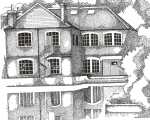
"Leaving the village by the path across the marshes west of the church (Mitcham) the low rumble of a waterwheel betokens a mill at work and the fragrance shows that it is snuff". Thus wrote Ogilvy in 1914. Coming upon the mill now, at the end of the park, you are more likely to hear the rumble of cars but something of that pleasant and cosy atmosphere evoked by the writer's words lingers on. Perhaps it emanates from the mill itself a solid faded yellow brick building with a hipped slate roof sitting astride the mill pond, and having the comfortable feel that long occupation gives a building. The largest of the buildings was a tobacco and snuff mill, built in the early 19th century. There were snuff mills here in the latter part of the 18th century, but the longest recorded occupation of the Ravensbury mill was that of the Rutter family, a John Rutter taking over the premises in 1805 and founding the tobacco and snuff manufacturing firm of John and Isaac Rutter which was to last until 1926.
| [Full size image 64.4kb] |
It was reputedly the last working mill on the river and during World War II the wheels were used to generate electricity. They still turned until the 1960s, operating wood-working machinery but became redundant when the river was diverted during flood prevention work by Surrey County Council.
| [Full size image 57.7kb] |
The last owners of the mill were Whitely Products, who purchased the factory from Rutters in 1926 for £4,200 (according to Prentis). Whitely's made sports goods but finally closed in the 198O's since when the mill has been empty. (Editor's Note - the first image above is from the Wandle Guide. The second is from a drawing by Peter Harris - somewhat less idealistic. Guess which one the developers at Ravensbury used!)
|
|
|
|